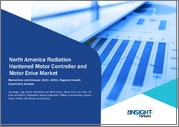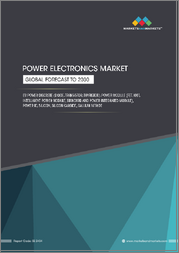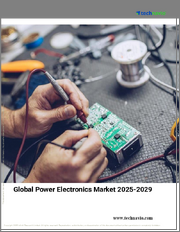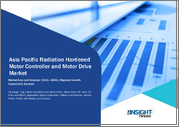
|
시장보고서
상품코드
1812028
파워 일렉트로닉스 장비 냉각 시스템 시장 : 세계 산업 규모, 점유율, 동향, 기회 및 예측 - 냉각 유형별, 정격 전력별, 용도별, 지역별 & 경쟁(2025-2030년)Power Electronics Equipment Cooling System Market - Global Industry Size, Share, Trends, Opportunity, and Forecast, Segmented By Cooling Type, By Power Rating, By Application, By Region, and By Competition, 2020-2030F |
||||||
세계의 파워 일렉트로닉스 장비 냉각 시스템 시장 규모는 2024년에 56억 3,000만 달러로 평가되었습니다. 예측 기간 중 연평균 복합 성장률(CAGR)은 7.74%로, 2030년에는 88억 9,000만 달러에 이를 것으로 예측됩니다.
| 시장 개요 | |
|---|---|
| 예측 기간 | 2026-2030년 |
| 시장 규모 : 2024년 | 56억 3,000만 달러 |
| 시장 규모 : 2030년 | 88억 9,000만 달러 |
| CAGR : 2025-2030년 | 7.74% |
| 급성장 부문 | 하이브리드 냉각 시스템 |
| 최대 시장 | 북미 |
자동차, 에너지, 가전, 데이터센터, 산업 생산 등 다양한 산업 분야에서 효율적인 열 관리 솔루션에 대한 수요가 증가함에 따라 세계 파워 일렉트로닉스 장비 냉각 시스템 시장은 강력한 성장세를 보이고 있습니다. 파워 일렉트로닉스는 전기자동차(EV), 재생에너지 발전 시스템, 고성능 컴퓨팅, 산업 자동화에 점점 더 많이 통합되고 있으며, 발열량이 증가함에 따라 신뢰성, 안전성, 효율성을 유지하기 위해 첨단 냉각 솔루션이 중요시되고 있습니다. 되고 있습니다. 효과적인 냉각 시스템은 에너지 손실을 최소화하고, 장치의 수명 주기를 연장하고, 섬세한 전자 부품의 안정적인 성능을 보장하는 데 필수적이며, 최신 고전력 용도의 중요한 원동력이 되고 있습니다.
기술의 발전으로 기존의 공랭식 냉각 방식은 점차 수냉식 또는 하이브리드 냉각 시스템으로 보완되거나 대체되고 있으며, 보다 효율적이고 컴팩트한 설계를 실현하고 있습니다. 콜드 플레이트와 침지 시스템을 포함한 수냉은 뛰어난 방열 능력으로 데이터센터, EV 파워트레인, 재생 에너지 컨버터에서 각광받고 있습니다. 한편, 열계면 재료, 상변화 기술, 열교환기 기술 혁신으로 시스템 성능은 더욱 향상되고 있습니다. 고밀도 서버 환경과 전기 이동성 인프라에서 침수 및 직접 수냉식 냉각의 채택이 확대되고 있는 것은 더 높은 전력 밀도를 지원할 수 있는 차세대 솔루션으로 시장이 이동하고 있음을 반영합니다.
주요 시장 성장 촉진요인
데이터센터의 에너지 수요와 냉각 수요 증가
주요 시장 이슈
높은 자본 비용과 운영 비용
주요 시장 동향
전기자동차(EV) 및 재생 에너지 부문 수요 증가
목차
제1장 개요
제2장 조사 방법
제3장 주요 요약
제4장 고객의 소리
제5장 세계의 파워 일렉트로닉스 장비 냉각 시스템 시장 전망
- 시장 규모와 예측
- 금액별
- 시장 점유율과 예측
- 냉각 유형별(공랭, 액랭, 하이브리드 냉각 시스템)
- 정격전력별(저전력(500kW 미만), 중전력(500 kW-5 MW), 고전력(5MW 이상))
- 용도별(자동차, 에너지 및 전력, IT 및 통신, 산업 제조, 가전제품, 기타)
- 지역별(북미, 유럽, 남미, 중동 및 아프리카, 아시아태평양)
- 기업별(2024년)
- 시장 맵
제6장 북미의 파워 일렉트로닉스 장비 냉각 시스템 시장 전망
- 시장 규모와 예측
- 시장 점유율과 예측
- 북미 : 국가별 분석
- 미국
- 캐나다
- 멕시코
제7장 유럽의 파워 일렉트로닉스 장비 냉각 시스템 시장 전망
- 시장 규모와 예측
- 시장 점유율과 예측
- 유럽 : 국가별 분석
- 독일
- 프랑스
- 영국
- 이탈리아
- 스페인
제8장 아시아태평양의 파워 일렉트로닉스 장비 냉각 시스템 시장 전망
- 시장 규모와 예측
- 시장 점유율과 예측
- 아시아태평양 : 국가별 분석
- 중국
- 인도
- 일본
- 한국
- 호주
제9장 중동 및 아프리카의 파워 일렉트로닉스 장비 냉각 시스템 시장 전망
- 시장 규모와 예측
- 시장 점유율과 예측
- 중동 및 아프리카 : 국가별 분석
- 사우디아라비아
- 아랍에미리트(UAE)
- 남아프리카공화국
제10장 남미의 파워 일렉트로닉스 장비 냉각 시스템 시장 전망
- 시장 규모와 예측
- 시장 점유율과 예측
- 남미 : 국가별 분석
- 브라질
- 콜롬비아
- 아르헨티나
제11장 시장 역학
- 성장 촉진요인
- 과제
제12장 시장 동향과 발전
- 인수합병(M&A)
- 제품 출시
- 최근 동향
제13장 기업 개요
- Vertiv Holdings Co.
- Aavid Thermalloy, LLC
- Advanced Cooling Technologies, Inc.
- Boyd Corporation
- Lytron Inc.
- Laird Thermal Systems
- Rittal GmbH & Co. KG
- Schneider Electric SE
- Johnson Controls International plc
- Noren Products Inc.
제14장 전략적 제안
제15장 회사 소개 및 면책조항
LSH 25.09.23The Global Power Electronics Equipment Cooling System Market was valued at USD 5.63 Billion in 2024 and is expected to reach USD 8.89 Billion by 2030 with a CAGR of 7.74% during the forecast period.
| Market Overview | |
|---|---|
| Forecast Period | 2026-2030 |
| Market Size 2024 | USD 5.63 Billion |
| Market Size 2030 | USD 8.89 Billion |
| CAGR 2025-2030 | 7.74% |
| Fastest Growing Segment | Hybrid Cooling Systems |
| Largest Market | North America |
The global Power Electronics Equipment Cooling System Market is witnessing robust growth, driven by the rising demand for efficient thermal management solutions across diverse industries such as automotive, energy, consumer electronics, data centers, and industrial manufacturing. Power electronics are increasingly embedded in electric vehicles (EVs), renewable energy systems, high-performance computing, and industrial automation, leading to higher heat generation and greater emphasis on advanced cooling solutions to maintain reliability, safety, and efficiency. Effective cooling systems are essential for minimizing energy losses, extending device lifecycles, and ensuring stable performance of sensitive electronic components, making them a critical enabler for modern high-power applications.
Technological advancements are reshaping the market, with traditional air-cooling methods being gradually complemented or replaced by liquid and hybrid cooling systems that offer higher efficiency and compact designs. Liquid cooling, including cold plates and immersion systems, is gaining traction in data centers, EV powertrains, and renewable energy converters due to its superior heat dissipation capabilities. Meanwhile, innovations in thermal interface materials, phase-change technologies, and heat exchangers are further enhancing system performance. The growing adoption of immersion and direct liquid cooling in high-density server environments and electric mobility infrastructure reflects the market's shift toward next-generation solutions capable of handling higher power densities.
Key Market Drivers
Rising Data Center Energy Demand and Cooling Needs
The exponential growth of digital infrastructure has intensified the demand for advanced cooling systems in power electronics. Data centers are consuming unprecedented amounts of electricity, with forecasts suggesting an additional 20 GW of power demand by 2030. Energy consumption is expected to represent between 6.7-12% of national power usage by 2028, up from 4.4% in 2023. Traditional air-cooling methods often result in an average PUE (Power Usage Effectiveness) of 1.58, whereas advanced liquid cooling can reduce this figure to nearly 1.1, demonstrating much higher efficiency. Moreover, cooling-related issues are responsible for over 40% of data center downtime, highlighting the operational risks of outdated thermal management. Advanced liquid and immersion cooling solutions can cut overall energy consumption by up to 50%, providing significant cost savings. These improvements are vital as data centers scale operations, ensuring reliability, efficiency, and compliance with sustainability goals.
Key Market Challenges
High Capital and Operational Costs
One of the primary challenges in the global power electronics equipment cooling system market is the high capital investment and operating costs associated with advanced cooling solutions. While air-cooling systems are relatively inexpensive, liquid cooling, immersion cooling, and hybrid systems require significant upfront infrastructure investment. For example, immersion cooling units can cost up to 15-20 times more than conventional air systems. Beyond installation, operators must bear recurring costs for specialized dielectric fluids, pumps, chillers, and maintenance protocols. Smaller enterprises, especially in emerging economies, often find these costs prohibitive. Moreover, retrofitting legacy facilities with advanced liquid cooling adds complexity and capital pressure, as existing infrastructure must often be redesigned to support new thermal management systems. Operationally, managing liquid leaks, coolant degradation, and ensuring fluid compatibility with sensitive electronics adds to cost burdens. As industries scale computing workloads, especially in AI and data centers, the total cost of ownership for next-generation cooling becomes a major decision-making barrier. This cost challenge creates a market divide: hyperscalers and large enterprises adopt high-end systems, while small and medium businesses remain dependent on less efficient, lower-cost solutions. Bridging this cost-performance gap remains a pressing obstacle for manufacturers and integrators.
Key Market Trends
Increasing Demand from Electric Vehicle (EV) and Renewable Energy Sectors
The electrification of transportation and the expansion of renewable energy infrastructure are creating new opportunities for advanced cooling systems. EV batteries, inverters, and charging infrastructure generate significant heat, requiring compact, high-performance liquid cooling systems. As EV adoption grows, global charging networks are projected to expand by millions of units, each requiring reliable thermal management. Similarly, renewable energy applications such as solar inverters and wind turbine power converters rely on efficient cooling to maintain system reliability under variable operating conditions. Advanced cooling solutions can extend component life by over 20% and improve efficiency by up to 15%. Governments' push for clean energy and electric mobility is accelerating demand, making the EV and renewable energy sectors two of the fastest-growing end-users for power electronics cooling systems. This trend positions cooling solutions as a key enabler of the global energy transition.
Key Market Players
- Vertiv Holdings Co.
- Aavid Thermalloy, LLC
- Advanced Cooling Technologies, Inc.
- Boyd Corporation
- Lytron Inc.
- Laird Thermal Systems
- Rittal GmbH & Co. KG
- Schneider Electric SE
- Johnson Controls International plc
- Noren Products Inc.
Report Scope:
In this report, the Global Power Electronics Equipment Cooling System Market has been segmented into the following categories, in addition to the industry trends which have also been detailed below:
Power Electronics Equipment Cooling System Market, By Cooling Type:
- Air Cooling
- Liquid Cooling
- Hybrid Cooling Systems
Power Electronics Equipment Cooling System Market, By Power Rating:
- Low Power (Below 500 kW)
- Medium Power (500 kW - 5 MW)
- High Power (Above 5 MW)
Power Electronics Equipment Cooling System Market, By Application:
- Automotive
- Energy & Power
- IT & Telecom
- Industrial Manufacturing
- Consumer Electronics
- Others
Power Electronics Equipment Cooling System Market, By Region:
- North America
- United States
- Canada
- Mexico
- Europe
- Germany
- France
- United Kingdom
- Italy
- Spain
- South America
- Brazil
- Argentina
- Colombia
- Asia-Pacific
- China
- India
- Japan
- South Korea
- Australia
- Middle East & Africa
- Saudi Arabia
- UAE
- South Africa
Competitive Landscape
Company Profiles: Detailed analysis of the major companies present in the Global Power Electronics Equipment Cooling System Market.
Available Customizations:
Global Power Electronics Equipment Cooling System Market report with the given market data, Tech Sci Research offers customizations according to a company's specific needs. The following customization options are available for the report:
Company Information
- Detailed analysis and profiling of additional market players (up to five).
Table of Contents
1. Product Overview
- 1.1. Market Definition
- 1.2. Scope of the Market
- 1.2.1. Markets Covered
- 1.2.2. Years Considered for Study
- 1.2.3. Key Market Segmentations
2. Research Methodology
- 2.1. Objective of the Study
- 2.2. Baseline Methodology
- 2.3. Key Industry Partners
- 2.4. Major Association and Secondary Sources
- 2.5. Forecasting Methodology
- 2.6. Data Triangulation & Validation
- 2.7. Assumptions and Limitations
3. Executive Summary
- 3.1. Overview of the Market
- 3.2. Overview of Key Market Segmentations
- 3.3. Overview of Key Market Players
- 3.4. Overview of Key Regions/Countries
- 3.5. Overview of Market Drivers, Challenges, and Trends
4. Voice of Customer
5. Global Power Electronics Equipment Cooling System Market Outlook
- 5.1. Market Size & Forecast
- 5.1.1. By Value
- 5.2. Market Share & Forecast
- 5.2.1. By Cooling Type (Air Cooling, Liquid Cooling, Hybrid Cooling Systems)
- 5.2.2. By Power Rating (Low Power (Below 500 kW), Medium Power (500 kW - 5 MW), High Power (Above 5 MW))
- 5.2.3. By Application (Automotive, Energy & Power, IT & Telecom, Industrial Manufacturing, Consumer Electronics, Others)
- 5.2.4. By Region (North America, Europe, South America, Middle East & Africa, Asia Pacific)
- 5.3. By Company (2024)
- 5.4. Market Map
6. North America Power Electronics Equipment Cooling System Market Outlook
- 6.1. Market Size & Forecast
- 6.1.1. By Value
- 6.2. Market Share & Forecast
- 6.2.1. By Cooling Type
- 6.2.2. By Power Rating
- 6.2.3. By Application
- 6.2.4. By Country
- 6.3. North America: Country Analysis
- 6.3.1. United States Power Electronics Equipment Cooling System Market Outlook
- 6.3.1.1. Market Size & Forecast
- 6.3.1.1.1. By Value
- 6.3.1.2. Market Share & Forecast
- 6.3.1.2.1. By Cooling Type
- 6.3.1.2.2. By Power Rating
- 6.3.1.2.3. By Application
- 6.3.1.1. Market Size & Forecast
- 6.3.2. Canada Power Electronics Equipment Cooling System Market Outlook
- 6.3.2.1. Market Size & Forecast
- 6.3.2.1.1. By Value
- 6.3.2.2. Market Share & Forecast
- 6.3.2.2.1. By Cooling Type
- 6.3.2.2.2. By Power Rating
- 6.3.2.2.3. By Application
- 6.3.2.1. Market Size & Forecast
- 6.3.3. Mexico Power Electronics Equipment Cooling System Market Outlook
- 6.3.3.1. Market Size & Forecast
- 6.3.3.1.1. By Value
- 6.3.3.2. Market Share & Forecast
- 6.3.3.2.1. By Cooling Type
- 6.3.3.2.2. By Power Rating
- 6.3.3.2.3. By Application
- 6.3.3.1. Market Size & Forecast
- 6.3.1. United States Power Electronics Equipment Cooling System Market Outlook
7. Europe Power Electronics Equipment Cooling System Market Outlook
- 7.1. Market Size & Forecast
- 7.1.1. By Value
- 7.2. Market Share & Forecast
- 7.2.1. By Cooling Type
- 7.2.2. By Power Rating
- 7.2.3. By Application
- 7.2.4. By Country
- 7.3. Europe: Country Analysis
- 7.3.1. Germany Power Electronics Equipment Cooling System Market Outlook
- 7.3.1.1. Market Size & Forecast
- 7.3.1.1.1. By Value
- 7.3.1.2. Market Share & Forecast
- 7.3.1.2.1. By Cooling Type
- 7.3.1.2.2. By Power Rating
- 7.3.1.2.3. By Application
- 7.3.1.1. Market Size & Forecast
- 7.3.2. France Power Electronics Equipment Cooling System Market Outlook
- 7.3.2.1. Market Size & Forecast
- 7.3.2.1.1. By Value
- 7.3.2.2. Market Share & Forecast
- 7.3.2.2.1. By Cooling Type
- 7.3.2.2.2. By Power Rating
- 7.3.2.2.3. By Application
- 7.3.2.1. Market Size & Forecast
- 7.3.3. United Kingdom Power Electronics Equipment Cooling System Market Outlook
- 7.3.3.1. Market Size & Forecast
- 7.3.3.1.1. By Value
- 7.3.3.2. Market Share & Forecast
- 7.3.3.2.1. By Cooling Type
- 7.3.3.2.2. By Power Rating
- 7.3.3.2.3. By Application
- 7.3.3.1. Market Size & Forecast
- 7.3.4. Italy Power Electronics Equipment Cooling System Market Outlook
- 7.3.4.1. Market Size & Forecast
- 7.3.4.1.1. By Value
- 7.3.4.2. Market Share & Forecast
- 7.3.4.2.1. By Cooling Type
- 7.3.4.2.2. By Power Rating
- 7.3.4.2.3. By Application
- 7.3.4.1. Market Size & Forecast
- 7.3.5. Spain Power Electronics Equipment Cooling System Market Outlook
- 7.3.5.1. Market Size & Forecast
- 7.3.5.1.1. By Value
- 7.3.5.2. Market Share & Forecast
- 7.3.5.2.1. By Cooling Type
- 7.3.5.2.2. By Power Rating
- 7.3.5.2.3. By Application
- 7.3.5.1. Market Size & Forecast
- 7.3.1. Germany Power Electronics Equipment Cooling System Market Outlook
8. Asia Pacific Power Electronics Equipment Cooling System Market Outlook
- 8.1. Market Size & Forecast
- 8.1.1. By Value
- 8.2. Market Share & Forecast
- 8.2.1. By Cooling Type
- 8.2.2. By Power Rating
- 8.2.3. By Application
- 8.2.4. By Country
- 8.3. Asia Pacific: Country Analysis
- 8.3.1. China Power Electronics Equipment Cooling System Market Outlook
- 8.3.1.1. Market Size & Forecast
- 8.3.1.1.1. By Value
- 8.3.1.2. Market Share & Forecast
- 8.3.1.2.1. By Cooling Type
- 8.3.1.2.2. By Power Rating
- 8.3.1.2.3. By Application
- 8.3.1.1. Market Size & Forecast
- 8.3.2. India Power Electronics Equipment Cooling System Market Outlook
- 8.3.2.1. Market Size & Forecast
- 8.3.2.1.1. By Value
- 8.3.2.2. Market Share & Forecast
- 8.3.2.2.1. By Cooling Type
- 8.3.2.2.2. By Power Rating
- 8.3.2.2.3. By Application
- 8.3.2.1. Market Size & Forecast
- 8.3.3. Japan Power Electronics Equipment Cooling System Market Outlook
- 8.3.3.1. Market Size & Forecast
- 8.3.3.1.1. By Value
- 8.3.3.2. Market Share & Forecast
- 8.3.3.2.1. By Cooling Type
- 8.3.3.2.2. By Power Rating
- 8.3.3.2.3. By Application
- 8.3.3.1. Market Size & Forecast
- 8.3.4. South Korea Power Electronics Equipment Cooling System Market Outlook
- 8.3.4.1. Market Size & Forecast
- 8.3.4.1.1. By Value
- 8.3.4.2. Market Share & Forecast
- 8.3.4.2.1. By Cooling Type
- 8.3.4.2.2. By Power Rating
- 8.3.4.2.3. By Application
- 8.3.4.1. Market Size & Forecast
- 8.3.5. Australia Power Electronics Equipment Cooling System Market Outlook
- 8.3.5.1. Market Size & Forecast
- 8.3.5.1.1. By Value
- 8.3.5.2. Market Share & Forecast
- 8.3.5.2.1. By Cooling Type
- 8.3.5.2.2. By Power Rating
- 8.3.5.2.3. By Application
- 8.3.5.1. Market Size & Forecast
- 8.3.1. China Power Electronics Equipment Cooling System Market Outlook
9. Middle East & Africa Power Electronics Equipment Cooling System Market Outlook
- 9.1. Market Size & Forecast
- 9.1.1. By Value
- 9.2. Market Share & Forecast
- 9.2.1. By Cooling Type
- 9.2.2. By Power Rating
- 9.2.3. By Application
- 9.2.4. By Country
- 9.3. Middle East & Africa: Country Analysis
- 9.3.1. Saudi Arabia Power Electronics Equipment Cooling System Market Outlook
- 9.3.1.1. Market Size & Forecast
- 9.3.1.1.1. By Value
- 9.3.1.2. Market Share & Forecast
- 9.3.1.2.1. By Cooling Type
- 9.3.1.2.2. By Power Rating
- 9.3.1.2.3. By Application
- 9.3.1.1. Market Size & Forecast
- 9.3.2. UAE Power Electronics Equipment Cooling System Market Outlook
- 9.3.2.1. Market Size & Forecast
- 9.3.2.1.1. By Value
- 9.3.2.2. Market Share & Forecast
- 9.3.2.2.1. By Cooling Type
- 9.3.2.2.2. By Power Rating
- 9.3.2.2.3. By Application
- 9.3.2.1. Market Size & Forecast
- 9.3.3. South Africa Power Electronics Equipment Cooling System Market Outlook
- 9.3.3.1. Market Size & Forecast
- 9.3.3.1.1. By Value
- 9.3.3.2. Market Share & Forecast
- 9.3.3.2.1. By Cooling Type
- 9.3.3.2.2. By Power Rating
- 9.3.3.2.3. By Application
- 9.3.3.1. Market Size & Forecast
- 9.3.1. Saudi Arabia Power Electronics Equipment Cooling System Market Outlook
10. South America Power Electronics Equipment Cooling System Market Outlook
- 10.1. Market Size & Forecast
- 10.1.1. By Value
- 10.2. Market Share & Forecast
- 10.2.1. By Cooling Type
- 10.2.2. By Power Rating
- 10.2.3. By Application
- 10.2.4. By Country
- 10.3. South America: Country Analysis
- 10.3.1. Brazil Power Electronics Equipment Cooling System Market Outlook
- 10.3.1.1. Market Size & Forecast
- 10.3.1.1.1. By Value
- 10.3.1.2. Market Share & Forecast
- 10.3.1.2.1. By Cooling Type
- 10.3.1.2.2. By Power Rating
- 10.3.1.2.3. By Application
- 10.3.1.1. Market Size & Forecast
- 10.3.2. Colombia Power Electronics Equipment Cooling System Market Outlook
- 10.3.2.1. Market Size & Forecast
- 10.3.2.1.1. By Value
- 10.3.2.2. Market Share & Forecast
- 10.3.2.2.1. By Cooling Type
- 10.3.2.2.2. By Power Rating
- 10.3.2.2.3. By Application
- 10.3.2.1. Market Size & Forecast
- 10.3.3. Argentina Power Electronics Equipment Cooling System Market Outlook
- 10.3.3.1. Market Size & Forecast
- 10.3.3.1.1. By Value
- 10.3.3.2. Market Share & Forecast
- 10.3.3.2.1. By Cooling Type
- 10.3.3.2.2. By Power Rating
- 10.3.3.2.3. By Application
- 10.3.3.1. Market Size & Forecast
- 10.3.1. Brazil Power Electronics Equipment Cooling System Market Outlook
11. Market Dynamics
- 11.1. Drivers
- 11.2. Challenges
12. Market Trends and Developments
- 12.1. Merger & Acquisition (If Any)
- 12.2. Product Launches (If Any)
- 12.3. Recent Developments
13. Company Profiles
- 13.1. Vertiv Holdings Co.
- 13.1.1. Business Overview
- 13.1.2. Key Revenue and Financials
- 13.1.3. Recent Developments
- 13.1.4. Key Personnel
- 13.1.5. Key Product/Services Offered
- 13.2. Aavid Thermalloy, LLC
- 13.3. Advanced Cooling Technologies, Inc.
- 13.4. Boyd Corporation
- 13.5. Lytron Inc.
- 13.6. Laird Thermal Systems
- 13.7. Rittal GmbH & Co. KG
- 13.8. Schneider Electric SE
- 13.9. Johnson Controls International plc
- 13.10. Noren Products Inc.
14. Strategic Recommendations
15. About Us & Disclaimer
(주말 및 공휴일 제외)


















